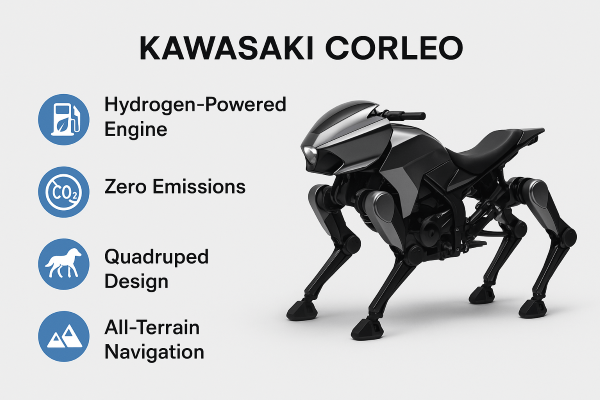Meet Corleo, Kawasaki’s robot horse concept, and what the company calls a revolutionary mobility experience. What is Kawasaki known for? Two-wheel mobility. And although two wheels can take you places four-wheelers can’t, Corleo can go many steps further to places where only a horse can go. So why not just get a horse?
Kawasaki featured Corleo at this year’s Kansai Expo in Osaka, Japan. The robot uses a hydrogen fuel cell for power. Its onboard artificial intelligence (AI) provides visual navigation with terrain analysis, ensures stability when responding to a rider, optimizes its legs and the placement of its four rubber-treaded hooves, and comes with many safety features.
The rider sits on an adjustable saddle astride Corleo. The saddle can accommodate two. The robot steers in response to the rider’s body movement and the shifting of weight. Instead of reins, Corleo comes with handlebars.
The Corleo displayed in Osaka could demonstrate fundamental leg movements. It was not yet operational. To fill in the imagination gaps, Kawasaki produced several promotional videos showing Corleo galloping across mountainous terrain and leaping gullies. Needless to say, it was the hit of the show.
Before robots had legs, they had arms and wheels. The arm-equipped robots were used in manufacturing. The wheeled robots found a market niche with vacuuming and floor cleaning. These were like my iRobot vacuum cleaner using actuators and motors to navigate and orient itself to its surroundings. The onboard sensors provide collision detection, and the wheels and motors the locomotion.
My iRobot randomly crosses a floor and can get under low-clearance furniture. When its onboard sensor detects a low battery, it navigates to its docking station to recharge. Often, it doesn’t make it, and I have to pick it up to dock it. Mine is a first-generation iRobot basic model, and when we first got it was fun to watch as it meandered through our rooms. Second and third-generation robot vacuums, however, make that first iRobot seem toylike. The robot vacuum cleaners today are programmable, have onboard cameras and sensors to self-navigate and even empty the dustbin.
Four-legged or quadruped robots are more sophisticated than wheeled robots like iRobot. Quadrupeds mimic the movement of dogs and other four-legged animals. There are even six and eight-legged robots with locomotion similar to insects and spiders. Even stranger still, there are legless and wheelless robots that use surface-embedded actuators to move them like worms and snakes.
Corleo is a quadruped robot with a low centre of gravity to make it extremely stable. Some quadruped robots from companies like Boston Dynamics can operate autonomously, while others are semi-autonomous and operated remotely through a human handler.
Quadruped robots are equipped with onboard computing technology packed with sophisticated software algorithms to give them the ability to create three-dimensional maps of the surrounding environment. Actuators and servomotors control their movements and responses to external stimuli.
For a robot attempting to be a horse and rider, the sensors and actuators needed have to respond to the passenger’s subtle body shifts or vigorous flexes and interpret them using perceptive locomotion and navigational guidance technology. The robot needs to know what is and isn’t a safe speed.
When Kawaski moves Corleo from concept to build, all of the above will need to be incorporated into the robot’s design. Its sensors will not only tell what is underfoot but also analyze surrounding environmental conditions that would affect its operational capability.
While still a concept that is likely more than a decade away from becoming a working robot, it feels more like science fiction than reality. If Corleo finally gets built, the consequences are interesting because it will allow us to step back in time before technologies like the “horseless carriage” and railways replaced horses as our primary means of transportation. This time, however, horse robots on our streets won’t be accompanied by piles of horse manure.
For equestrians who love riding horses, the robot horses of the future may make riding even more exciting with these intelligent machines capable of delivering leaps and adventures no living horse could do. For a sense of what that experience could be, click on this Kawasaki-produced video to watch Corleo in action.









